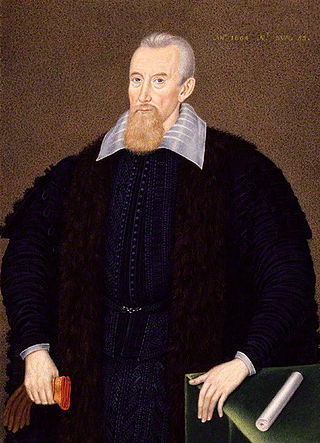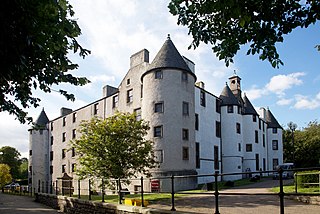Related Research Articles

Alexander Seton, 1st Earl of Dunfermline (1555–1622) was a Scottish lawyer, judge and politician. He served as Lord President of the Court of Session from 1598 to 1604, Lord Chancellor of Scotland from 1604 to 1622 and as a Lord High Commissioner to the Parliament of Scotland.

Ludovic Stewart, 2nd Duke of Lennox and 1st Duke of Richmond, lord of the Manor of Cobham, Kent, was a Scottish nobleman who through their paternal lines was a second cousin of King James VI of Scotland and I of England. He was involved in the Plantation of Ulster in Ireland and the colonization of Maine in New England. Richmond's Island and Cape Richmond as well as Richmond, Maine, are named after him. His magnificent monument with effigies survives in Westminster Abbey.
Alexander Home, 1st Earl of Home and 6th Lord Home was a Scottish nobleman and Lord Warden-general of all the March.

Edward Bruce, 1st Lord Kinloss PC was a Scottish lawyer and judge.

Francis Stewart, 5th Earl of Bothwell was Commendator of Kelso Abbey and Coldingham Priory, a Privy Counsellor and Lord High Admiral of Scotland. He was a notorious conspirator, who led several uprisings against King James VI and died in poverty, in Italy, after being banished from Scotland. Francis was the first cousin of King James VI of Scotland. Francis's maternal uncle James Hepburn, 4th Earl of Bothwell was the chief suspect in the murder of James VI's father Henry Stuart, Lord Darnley.
Sir John Carmichael was a Scottish soldier, the Keeper of Liddesdale, a diplomat, and owner of Fenton Tower at Kingston, East Lothian.
Robert Bowes (1535?–1597) was an English diplomat, stationed as permanent ambassador to Scotland from 1577 to 1583.
Sir David Foulis was a Scottish baronet and politician.
Sir Roger Aston of Cranford, Middlesex, was an English courtier and favourite of James VI of Scotland.
Thomas Foulis was a Scottish goldsmith, mine entrepreneur, and royal financier.
John Arnot of Birswick (Orkney) (1530–1616) was a 16th-century Scottish merchant and landowner who served as Lord Provost of Edinburgh from 1587 to 1591 and from 1608 to death. He was Deputy Treasurer to King James VI.
Sir James Sandilands was a courtier to King James VI and I and captain of Blackness Castle
Francis Mowbray or Moubray was a Scottish intriguer.
George Nicholson or Nicolson, was an English diplomat in Scotland.
Alexander Home of North Berwick was a Scottish landowner and Provost of Edinburgh.

James Scrimgeour Scottish landowner and Constable of Dundee.
Archibald Wauchope of Niddrie Scottish landowner and rebel.

Queen Elizabeth I of England paid a subsidy to King James VI of Scotland from 1586 to 1602. This enabled her to influence James by delaying or deferring payments to his diplomats in London. Records survive of the yearly amounts, and details of the expenditure in some years. A large proportion of the money was spent on the royal wardrobe of James and Anne of Denmark. Some royal expenses were met by Anne of Denmark's dowry, which was known as the "tocher". The regular incomes of the Scottish crown were feudal rents, customs, and "compositions" charged on grants of land. Accounts for royal incomes and payments survive as the exchequer rolls and lord treasurer's accounts and have been published as historical sources.

James Douglas of Spott was a Scottish landowner and conspirator.
William Stewart was a Scottish sea captain from Dundee. Stewart was skipper of one of the ships that took James VI to Norway in 1589, when the king sailed to meet Anne of Denmark. James VI gave him a present of 20 dalers from his dowry. He was involved in a complex international shipping incident off the coast of Spain in 1593, as skipper of a ship belonging to George Bruce of Carnock.
References
- ↑ "BOWES, Sir William (d.1611), of Streatlam, co. Dur". History of Parliament Online. Retrieved 10 October 2016.
- ↑ Mackie, J. D., Calendar of State Papers Scotland, vol. 13 part 1 (Edinburgh, 1969), xx-xxi; Bruce, John, ed., Letters of Queen Elizabeth and King James VI of Scotland (Camden Society, 1849), pp.135–8.
- ↑ Calendar State Papers Scotland: 1595-1597, vol. 12 (Edinburgh, 1952), pp. 535, 559–566.
- ↑ John Duncan Mackie, Calendar of State Papers Scotland, 13:1 (Edinburgh, 1969), pp. 4–5, 21, 24.
- ↑ Calendar of State Papers Scotland, vol. 13 part 1 (Edinburgh, 1969) pp. 156–160.
- ↑ John Duncan Mackie, Calendar of State Papers Scotland, 13:1 (Edinburgh, 1969), pp. 193–4.
- ↑ Calendar State Papers Scotland, 13:1 (Edinburgh, 1969), pp. 514–5.
- ↑ Mackie, J. D., ed., Calendar of State Papers Scotland, vol. 13 part 1 (Edinburgh, 1969), xx–xxi.
- ↑ George Seton, Memoir of Alexander Seton (Edinburgh, 1882), pp. 58-60.
- ↑ William Kelly, Royal Progresses and Visits to Leicester (Leicester, 1884), pp. 328-331.
- ↑ Walter Seton, 'Early Years of Henry Frederick, Prince of Wales, and Charles, Duke of Albany', Scottish Historical Review, 13:52 (July 1916), pp. 373-4.
- ↑ see History of Parliament/ IHR